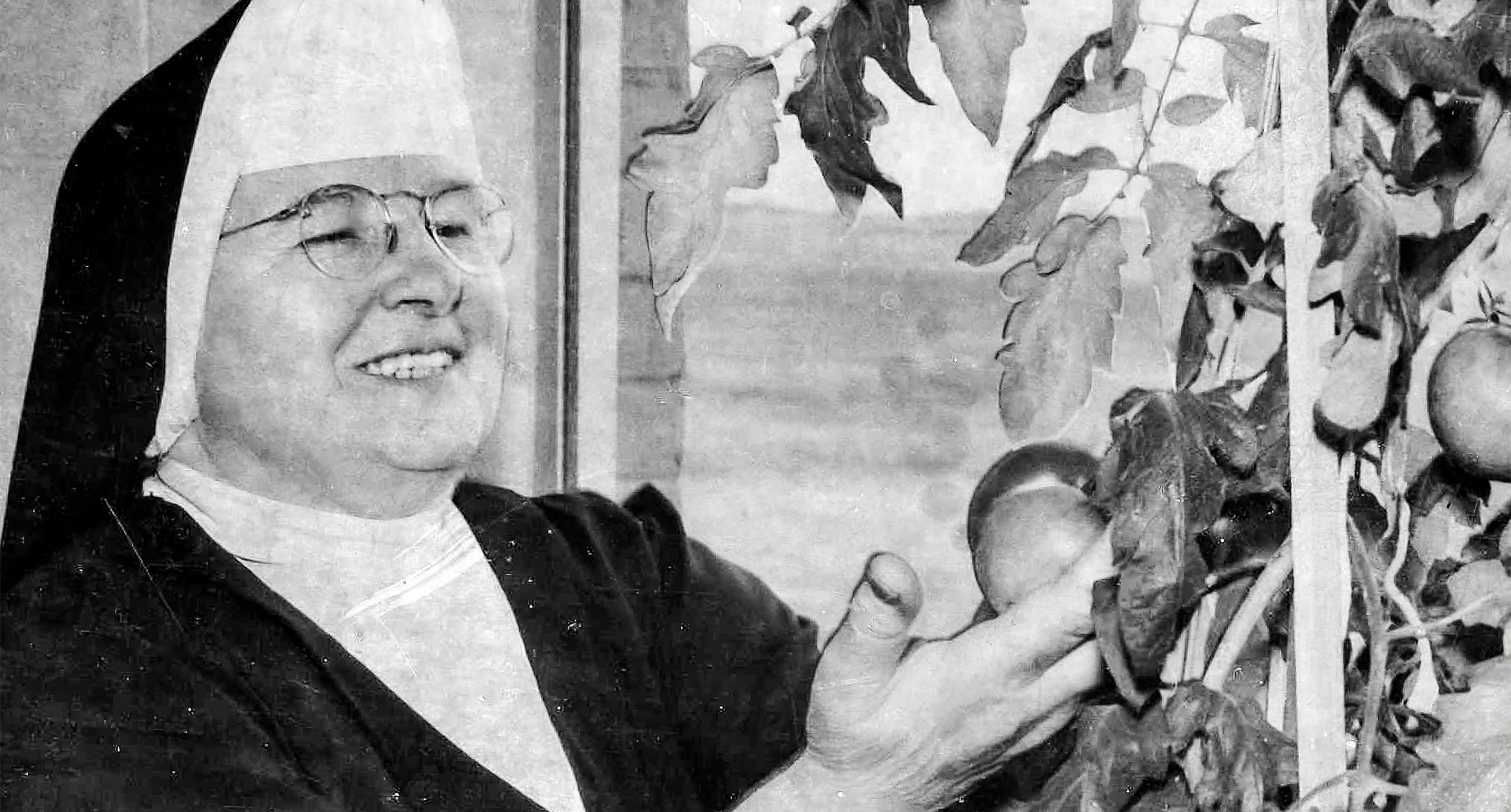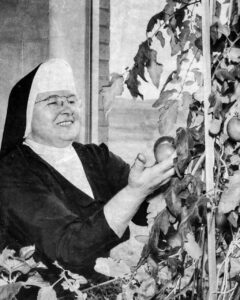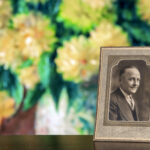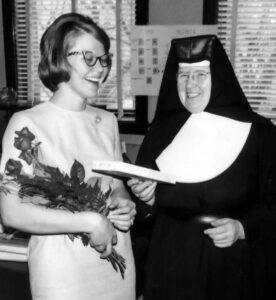


Sister Louis was physically distinct because of her sturdy proportions, and she was also intellectually impressive. She spoke in long, complete sentences, handled complex explanations about biology and chemistry without hesitation, and she expected her students to apply themselves to their classwork.
Dressed in concealing attire, the faces of Presentation Sisters who were teachers in Aberdeen’s Catholic schools took on added emphasis when my classmates and I assessed their personalities. I recall Sister Louis gazing serenely across our classroom during exams, looking satisfied she had given us the information we needed to do well. Sister Louis could be stern, when necessary, but her gleaming grin was a more common expression. We fondly nicknamed her Sister Buddha.
Her profession to the Presentation congregation included dedication to teaching and devotion to worship, and she also happily labored in the expansive vegetable garden maintained by the Sisters and situated alongside their college and convent building. Some sisters remember her as the garden’s de facto manager. I grew up near that garden and saw Sister Louis and others weeding, pruning, and watering. I remember hearing conversations and sharp laughter coming from those gardeners and feeling awkward to witness nuns in such normal circumstances.
On that Earth Day in 1970, we gathered countless bags of garbage, heaping them onto piles covering spring’s greening grass. Before that debris was trucked to the city dump, Sister Louis convened her troop of volunteers. We were, I’m sure, completely unaware of why there was an Earth Day, but the sight of so much that had been so carelessly discarded was startling.
I figured she would scold the litter bugs, but instead she presented a tutorial about waste and thoughtlessness, and she began with one short, mysterious sentence.
“There is no such thing as away,” she declared, glancing toward the trash. I stared blankly at her, clueless about what that meant.
She continued the lesson as we stood in a semi-circle around her. Every single day, she said, we throw things away. Some people toss bottles or bags out their car windows, and they forget about them. If we place trash into a garbage can or send it up a smokestack or out a drainpipe, we think of it as gone, that we’ve thrown it away. But there is no such thing as ‘away.’ What we have really done is move something we describe as waste or garbage from one place to another. We may have even changed its form, but we truly cannot throw anything ‘away.’
I later realized that Sister Louis was the first environmentalist I knew. The years she taught at Roncalli corresponded with an era when smart, open-minded people were paying close attention to Rachel Carson, a gifted scientist and nature writer turned environmental activist. Aldo Leopold had already introduced the idea of ecological ethics and stewardship to the public though his writing, but Carson and her most important book, Silent Spring, took that proposition and added a confrontational posture while warning people about the dangers associated with certain agricultural chemicals. Her valiant crusade to halt the use of DDT was stubbornly resisted by the chemical industry, including an aggressive, underhanded effort to destroy her reputation. When Carson and her allies prevailed, their activism was quickly fruitful. Banning DDT triggered the remarkable resurgence of our continent’s bald eagle population, a species nearly exterminated by that chemical.
Carson’s book and her political campaigns protecting nature ignited that faction of Americans who admired and respected the natural world and the fragile, often imperceptible web of life that makes human existence possible. Organizations such as Friends of the Earth, the Sierra Club and the Audubon Society flourished as they became more politically and socially engaged. Simultaneous to the earliest earth days came a flurry of significant environmental protection laws. Never had any nation on Earth enacted such meaningful policies and requirements aiming to sustain the livability of our planet. It was, in my estimation, the start of a social movement as impactful and valuable as any in human history.
Beginning in the early 1970s, discussions about economic development began to include analysis forecasting the biological consequences of an idea, proposal, or project. A deeper mindfulness about how our behaviors and activities affect air, water, land, wildlife, and the health of people, began to influence public and private sector decision-making.
Environmentalism was controversial, especially during its earliest years. But the mainstream’s acknowledgement regarding environmentalism has matured. What was once ridiculed as extreme or radical, is now increasingly and properly viewed as fundamental and necessary.
There’s much more to be done, of course. Researchers continue to study and reveal alarming rates of pollution killing and sickening humans and other species. But headway has been made. Consider clean energy, pocket houses, recycling, pollution regulations, endangered species protections, municipal sewage facilities, professionally managed landfills, the rising popularity of organic food, and fines imposed on those who litter. Our environmental sensitivities have grown more informed and sophisticated during the past 50 years. Most of us now realize, for example, that the emitted byproducts of combusted fossil fuels do not float into space and harmlessly, magically disappear. As Sister Louis once said, “There is no such thing as away.” //
















